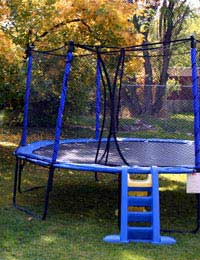 Garden trampolines have become extremely popular over the past few years and they are a great way for children to keep fit and active. However, it’s important that safety issues are considered carefully as although bumps and bruises are part and parcel in the life of a child, trampolines can result in more serious accidents and injuries if you and/or your children fail to take the proper safety precautions and ignore the dangers.
Garden trampolines have become extremely popular over the past few years and they are a great way for children to keep fit and active. However, it’s important that safety issues are considered carefully as although bumps and bruises are part and parcel in the life of a child, trampolines can result in more serious accidents and injuries if you and/or your children fail to take the proper safety precautions and ignore the dangers.
Key Safety Issues
Both parents and children tend to overlook the fact that a garden trampoline is not the same as a bouncy castle and although your children may want to get a few of their friends on the trampoline at the same time, this is ill advised as far more accidents have been reported when more than one person was on the trampoline at the same time and it’s usually the one weighing the lightest who is more at risk of suffering an accident.
Adult supervision is paramount too and, although you can’t necessarily prevent all injuries and accidents which might occur, it is far less likely if an adult is present as not only can they warn children if they’re getting a little over-exuberant, they can also help to stop the younger ones from falling off the trampoline.
Types of Injuries
Injuries can be inflicted on all parts of the body including the arms, legs and face but the more serious ones are usually to the head and neck areas.
Setting the Rules
Before your kids and their friends get overexcited about the prospect of bouncing up and down, it’s important that you get them to listen to a few basic ground rules first. In addition to there being only one person on the trampoline at any one time, you should also insist that there are no somersaults, backflips and any other kind of fancy ‘moves’ whilst on the trampoline.
Also, tell the children that on no account should they get off the trampoline by jumping off. They should come to a standstill and then get down. The kids who are waiting for their turn should also be told to stand back when someone else is jumping and not to go underneath the trampoline either.
The kids should be taught the risks and dangers of not using the trampoline properly. If they question a rule, be certain to explain to them clearly why it’s in place. They should also remove any jewellery, including necklaces, bracelets and watches and make sure they’re not wearing any loose clothing which may get caught.
Situating the Trampoline
You should situate the trampoline in a clear place and well away from potential hazards such as trees, washing lines, poles and other equipment which may get in the way. You should also ensure that there’s a ‘safe zone’ around the perimeter of the trampoline which should be at least 2.5 metres all the way around it. This should be kept clear from obstacles such as bikes, skateboards and other kids’ toys and preferably should consist of sand or some other kind of material such as bark shavings or safety matting which will provide cushioning in the event of a fall. Better still, why not buy a trampoline which comes with safety netting around it or buy an external safety cage which you can place all around it? It may cost more to do this but it will definitely keep your children safer and less likely to suffer serious injury by coming off the trampoline.
You should also follow the manufacturer’s instructions in how to erect the trampoline and inspect it each time before it is used. Make sure there is no damage to the frame and that there are no holes in the trampoline itself. Also make sure the legs are locked tight into a safe locked position and that all the padding is in place and is secure.
It’s important to remember that children who are under 6 should only use a trampoline that has been specifically designed for younger children but you shouldn’t be letting young toddlers on it until they are a bit older.
In following these basic safety guidelines, your children will get years of fun out of their garden trampoline without suffering any accidents or injuries.





Leave A Comment